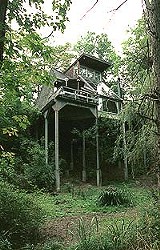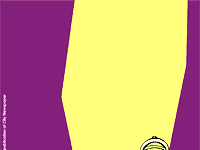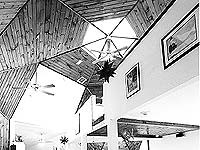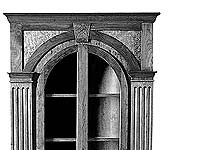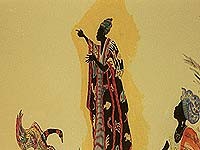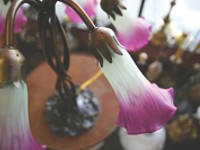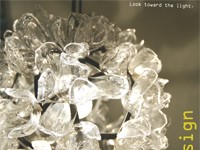[
{
"name": "500x250 Ad",
"insertPoint": "5",
"component": "15667920",
"parentWrapperClass": "",
"requiredCountToDisplay": "1"
}
]
"This is not a 'Hi honey, I'm home!' house," artist Annie Dunsky-Kälnitz says of her Pittsford residence. Pod-shaped and perched on 100-foot pylons on the side of a hill --- like a long-legged bug --- the house was dubbed the Floating House by its first owners. It was designed and built in the late 1970s by architect Jim Johnson, of Mushroom House fame.
The house is oriented away from the street and towards a lush tangle of woods to create privacy and foster an intimacy with nature. On the eastern side, a three-story bank of windows overlooks the trees and creek below. At the western side, facing the street, a blank, 80-foot-long, cedar-shingle wall maintains the private feeling of the home.
The land surrounding the house is, like the house, atypical. There's no lawn, nor is there any level ground to speak of --- just a steep hill. To get to the backyard you have to walk down dozens of steps. At the bottom, the Floating House looms above the scrub bushes that lead to the creek and woods.
"This is a retreat," Annie says. She's seen wild turkeys, deer, and great blue herons there. "Do you feel like you are in Pittsford?"
Inside, the house has an open plan, with the second and third floors opening onto the main space and the 30-foot wall of windows situated above the sunken conversation pit on the first floor.
"[Johnson] considers every angle," Annie says. "It's sensuous and massive. It's all about volume and space."
Up in the master bedroom, which has no doors, a low bed faces the windows. Leafy green light filters in from the canopy of trees outside. Only a slender railing stands between the bedroom and the spectacular view.
"It's like waking up in the jungle," Annie's husband, software developer Paul Kalnitz, says.
In addition to the proximity to nature, the couple revels in the details of their home. "Every inch is hand-considered, handmade," Annie says, pointing out a joint where two oddly angled roof sections come together perfectly. She loves the sleek walnut built-ins, the fireplace tiles, and the open-riser stairs. "Jim Johnson's houses are like sculptures. We're living in a sculpture."
Johnson studied with Bruce Goff, a professor of architecture at the University of Oklahoma, who combined unusual materials in unexpected ways to create buildings that are both plant-like and futuristic.
Johnson's projects include over 25 custom homes and numerous religious buildings, including St. John Evangelist in Greece, for which he won the Lillian Fairchild Award from the University of Rochester. His CV also lists a wide array of workaday design jobs, from the local (Altier's shoe stores) to the exotic (a dorm in Basrah, Iraq). Perhaps Johnson's most famous landmark design is the Liberty Pole downtown.
Decorating the Floating House might seem like an intimidating proposition, but not to its residents. They moved here 18 months ago from a big Tudor house, which, Paul says, just wasn't right for them.
"We had been buying modern things," he says, "and we were surprised at how well they all came together here." The home is furnished with architect-designed furniture, which they collect. And their colorful art-glass collection enlivens the surfaces. Annie's expressionistic paintings, which are hung here and there, add to the mix.
When they first saw the house a couple of years ago, Paul was initially put-off. "From the driveway, it looks like a shack," he says, referring to the long, featureless, cedar-shake wall.
"It's an antisocial house," Annie says, laughing. "That big wall says, 'Go away!'"
"But as soon as I came inside, I knew right away that I liked it," Paul says. "And I wanted a house where I wouldn't have to mow the lawn."
In This Guide...
Latest in Home Design
More by Jennifer Loviglio
-
The XX Files
Nov 15, 2006 -

Silent (politically correct) night
Nov 15, 2006 -
Escape to Jennitopia
Nov 1, 2006 - More »
